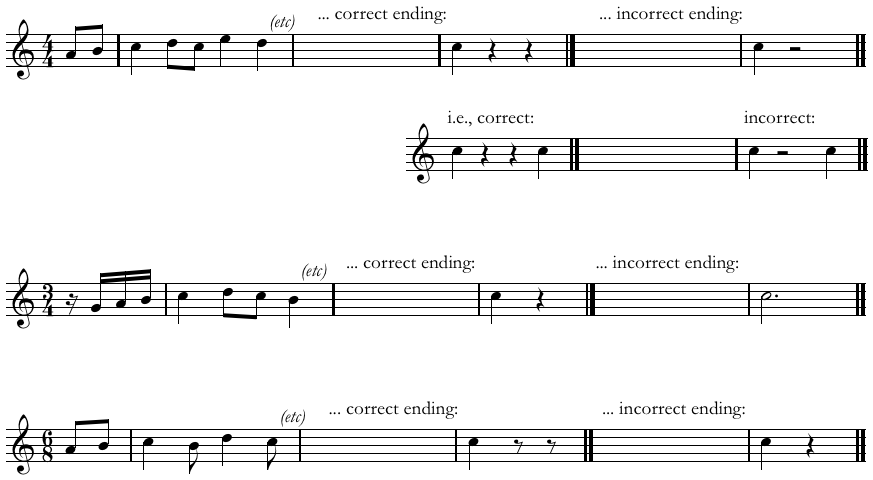Upbeats
In this guide...
Key terms:
Subscription required!
To view the complete study guide, you will need a valid subscription. Why not subscribe now?
Already have a subscription? Make sure you login first!
Introduction
Not all music has to start on the first beat of the bar! It is very common to have a few notes before the first beat to lead in, and in this guide we'll find out all about this technique.
What is an upbeat?
Consider the beginnings of these poems:
- There was an old man from Peru
Who dreamt he was eating his shoe ... - Mary had a little lamb,
Whose fleece was white as snow ...
In the first example, the emphasis is on "was", not "There", and in the second example, the emphasis is on the "Ma-"of "Mary".
If these were set to music, the first example would begin just before a barline (before the strong beat at the start of a bar), and example 2 would begin at the beginning of a bar, on the strong beat.
Upbeats and downbeats
In music, we would say that the first example above begins on an upbeat and the second example begins on a downbeat.
The strong first beat of the bar is always a downbeat, and the beat before a downbeat is always an upbeat. It might help to imagine a conductor, raising the baton before the first beat (the upbeat...), and bringing it down on the first beat (...the downbeat).
Alternative names
There are two other terms commonly used for an upbeat that you might come across.
- An anacrusis: This is a more fussy and technical word than "upbeat", but it is a bit clearer, because as we shall see, an "upbeat" does not necessarily span just one beat!
- A pickup, or "pickup notes": This term is used less formally, but like "anacrusis" has the advantage that it does not imply just a single beat before the barline.
Longer upbeats
An upbeat, pickup, or anacrusis does not have to consist of just one note. It can be several notes, so long as they don't start at the beginning of a bar, and so long as they lead up to a "downbeat" at the beginning of the following bar.
For example, in the song "Happy Birthday", "Happy" is set to two notes (over one beat), and it still forms the anacrusis to the "Birth-" of "Birthday".
The following example by Mozart has a five note anacrusis:
 A five note anacrusis in Mozart's Sonata no. 19 for piano
A five note anacrusis in Mozart's Sonata no. 19 for pianoUpbeat endings
Look at the following example, and in particular look at the duration of each bar:
 Winchester Old, also known as While Shepherds Watched
Winchester Old, also known as While Shepherds WatchedThe tune starts on an upbeat which lasts for one crotchet, and the time signature is 4/4. The final bar, however, has only three beats! Is that a mistake?
This isn't a mistake! The missing beat required to make up a complete 4/4 bar is the upbeat.
You will find a similar principle in all music that begins with an upbeat: the final bar is shortened by the length of the upbeat.
Vice-versa, we can say that the duration of the final bar plus the duration of the upbeat equals the duration of one complete bar. In the example above, 1 + 3 = 4 (1, the upbeat; 3, the final bar; 4, the length of a bar in 4/4)
A note about time signatures
A final bar that is incomplete because of an upbeat to the first bar is not the same as a bar of a different length due to a different time signature.
In "While Shepherds Watched", the final bar is not suddenly in 3/4: it is still in 4/4.
Therefore, any notes or rests in that bar must be grouped as if they are in 4/4, up to the point where the bar ends early.
You should be able to (in theory!) stitch the upbeat onto the end of the final bar, and in so doing, form a correctly-notated full bar of music.
Consider the following examples, which show correct and incorrect ways of notating an incomplete bar with an upbeat.
 Upbeat notation examples
Upbeat notation examplesIt is important that you notate the incomplete final bar in the correct time signature!
Common traps
If you take a music theory exam, or if you ever write out some music, you are quite likely to come across upbeats, and you must remember to notate the final bar correctly.
This is important to remember, for example, if you answer the "complete this phrase" question in the ABRSM Grade 5 Theory exam. Often this will open on an upbeat, and so you must remember to leave the final bar short by the time value of the upbeat.
Likewise, if you attempt the similar question in the exam which asks you to set some words to a tune, the words will often begin on an upbeat ("There was an old man from Peru...") - and so likewise, you must remember to leave the final bar short by the time value of the upbeat.
Read more...
With a subscription to Clements Theory you'll be able to read this and dozens of other study guides, along with thousands of practice questions and more! Why not subscribe now?
Revision
Are you sure you've understood everything in this study guide? Why not try the following practice questions, just to be sure!